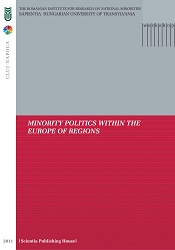Between “Independence in Europe”, a “Europe with a Hundred Flags”, and a “Europe of” or “with the Regions”. Conceptualising the Relation between Stateless Nations and European Integration in Western Europe (1945–2010)
Between “Independence in Europe”, a “Europe with a Hundred Flags”, and a “Europe of” or “with the Regions”. Conceptualising the Relation between Stateless Nations and European Integration in Western Europe (1945–2010)
Author(s): Klaus-Jürgen Nagel
Subject(s): Politics / Political Sciences, Law, Constitution, Jurisprudence
Published by: Scientia Kiadó
Keywords: European Integration; Western Europe; stateless nations; Second World War; European Economic Community; European Union
Summary/Abstract: Representatives of stateless nations in Western Europe have usually (but not always) taken positive views on European Integration but defend different standpoints on the role of their nations in this process. My paper describes the history of conceptualising the relation between the stateless nations and the process of European integration in Western Europe since the Second World War, looking for continuities and discontinuities. The starting point is the West European Europeanist movement. Under the influence of Proudhonian federalism, the “personalist” movement provided a first understanding of a “Europe of the regions”. The second chapter deals with the development of a “Europe of a hundred flags” (Yann Fouéré), that is the development of an alternative to the European Economic Community from the standpoint of stateless nations, different from the regions and substituting the old states. During the sixties and seventies, the “revolt of the province” brought a new understanding of this relation: In the framework of a protest movement against capitalist and state-controlled European integration, the fight against “internal colonialism” provided leftist nationalist groups in some stateless nations with a (partially) new ideological framework, defending alternative concepts of European integration. These ideas afterwards linked with green “small is beautiful” ideas (Leopold Kohr) of a bottom-up process of European Integration that would be based on the regions. However, the governments of the European Regions took up a very different approach in order to achieve regional inclusion in the institutional framework of the newly founded EU. This movement in favour of a “Europe of the regions” was partially successful. However, the Maastricht and post-Maastricht institutional structure and political practice can be probably better described as a “Europe with the regions”, where stateless nations do not find the asymmetrical recognition they claim. As a reaction, concepts of a “Europe of” (autochthonous) “ethnic groups” were developed at the far right of the party system (Vlaams Blok), while some of the nationalist movements of stateless nations formulated “independence in Europe” as their new goal, and thereby returned to the idea of the nation-state, albeit in the inclusive framework of a new European Union.
Book: MINORITY POLITICS WITHIN THE EUROPE OF REGIONS
- Page Range: 61-86
- Page Count: 26
- Publication Year: 2011
- Language: English
- Content File-PDF

